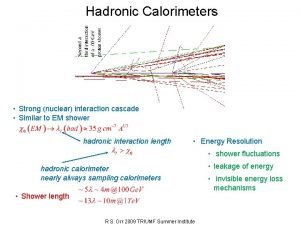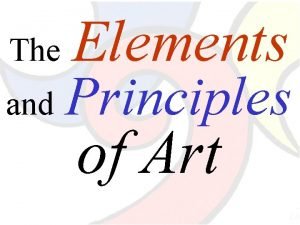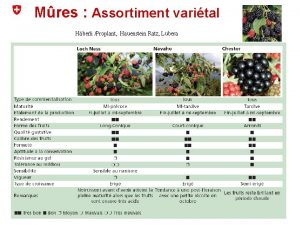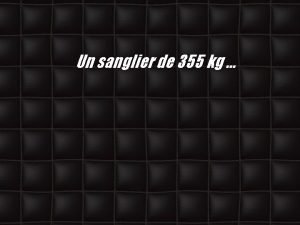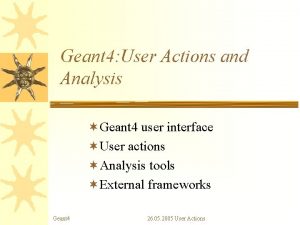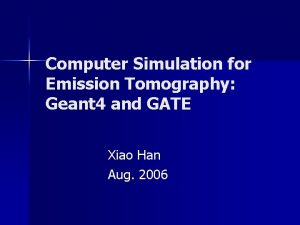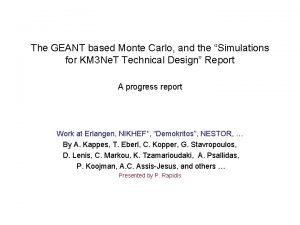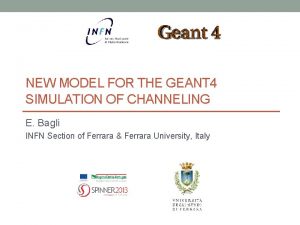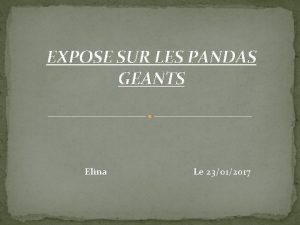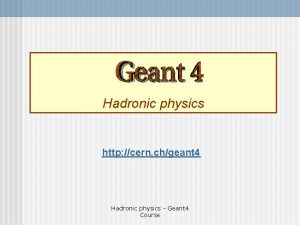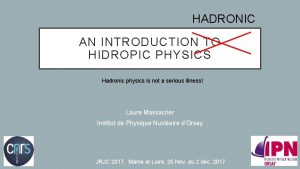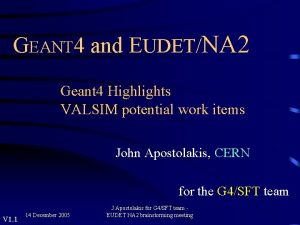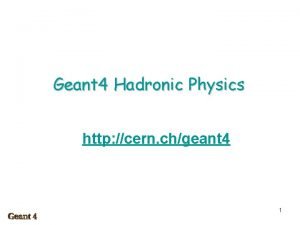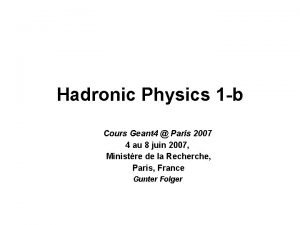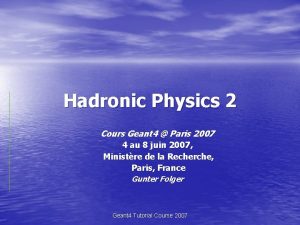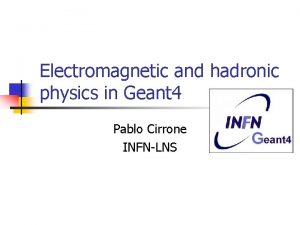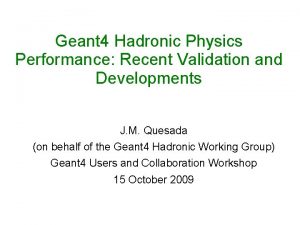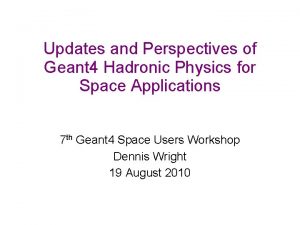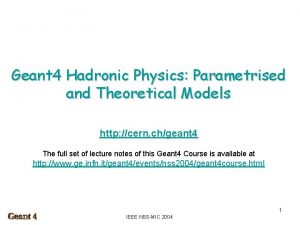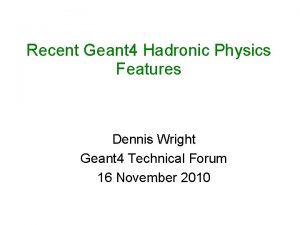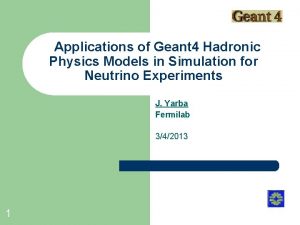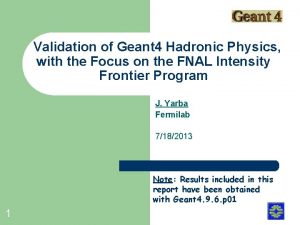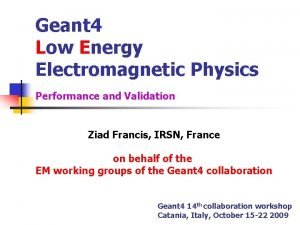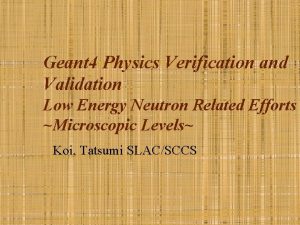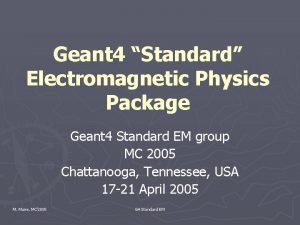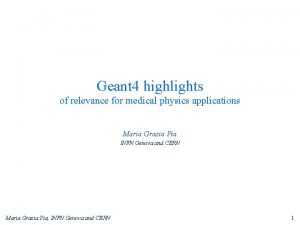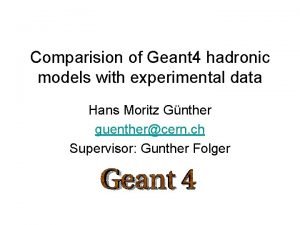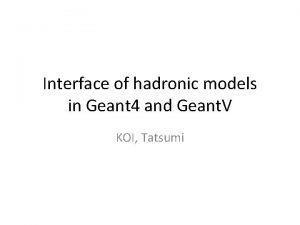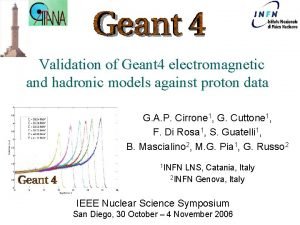Highlights in Low Energy Hadronic Physics Geant 4

























- Slides: 25

Highlights in Low Energy Hadronic Physics Geant 4 Collaboration Meeting 27 September 2017 Dennis Wright

Outline • De-excitation and Precompound • Low Energy Database Models • Radioactive decay • Nuclear Resonance Fluorescence • Neutrino Physics 2

Common Developments for Pre-compound/De-excitation • G 4 Deex. Preco. Parameters scheme introduced in 10. 3 is extended Printout of all important parameters values at initialisation Modification of parameters allowed only at G 4 State_Pre. Init New booleans added to allow disabling of de-excitation module • Only one singleton class G 4 Nuclear. Data. Store left with static data shared between all threads No longer any thread local data • Time and creator model information is propagated to G 4 Hadronic. Process Allowing proper checks of charge and energy conservation Emission of Auger electrons breaks old checks 3

De-excitation Module for 10. 4 • Evaporation/Fermi. Break. Up/Photon evaporation updated according to plan for 10. 4 • Data structure for gamma levels is finalized with G 4 Photon. Evaporation 5. 0 Half the size of data in 10. 3 Laurent Desorgher produced data files Fixed several bug reports for 10. 3 concerning radioactive decay and photon evaporation Optimized data structure: use double, float and integer with maximum compression of data • In all classes of the module excited energy of a fragment is taken from the DB directly without any conversion and not computed on-fly Providing reproducibility • Isomer production is enabled by default Time limit is taken from G 4 Nuclide. Table providing full synkronisation between production and decay 4

De-excitation Module for 10. 4 • Correlated gamma decay (Jason Detwiler, University of Washington) • Works for several important isotopes (Co 60) but provides very long loops if applied in general • Triggers non-reproducibility and slow-down in radioactive decay chain sampling • Enabled by request or by G 4 Radiactive. Decay. Physics May be disabled by default also for radioactive decay if problems will not be fixed before 10. 4 5

Double Differential Spectra of Neutrons for 22 Me. V Proton Beam The Binary cascade predicts more supressed low-energy part of the spectra than the Bertini cascade There are non-ideal description of the end of the spectra, which means that cascades are not accurate in sampling of quasi-elastic scattering 6

Double Differential Spectra of Neutrons for 256 Me. V Proton Beam The Binary cascade predicts more accurately forward neutron spectra The Bertini cascade is more accurate in the backward hemisphere 7

New Low Energy Photonuclear Model • G 4 LENDor. Bert. Model will use G 4 LEND models below 20 Me. V • database has g interaction information on isotopes from D to 241 Pu • for isotopes with no data, or for Eg > 20 Me. V Bertini • cross sections also come from LEND, unless no data, then use G 4 Photo. Nuclear. Cross. Section as we do now • G 4 LEND gamma models parallel the LEND neutron models: • fission, capture, inelastic, elastic • to simplify usage in physics lists, fission, capture, inelastic to be combined into one model, elastic in another • Existing physics list, Shielding. LEND will be modified to include new model 8

Geant 4/FLUKA Comparison, Quintieri et al. at SATIF 13 9

Cross Section Comparison, LEND vs. G 4 Photo. Nuclear. Cross. Section 10

Thermal Neutron Scattering Validation N. H. Tran @ CEA 11

Radioactive Decay • RDM mini-workshop held at CERN in April 2017 • Highlights • beta-delayed particle emission works for transitions to discrete levels • agreed to refactor RDM code into separate analogue and variance reduction models • • reduction in number of half-life limits used in code • photon evaporation and radioactive decay databases now consistent in format and notation (both taken from ENSDF) • new example: rdecay 03 RDM and IT code refactored to include correlated gamma emission 12

13

Radioactive Decay • • New radioactive decay models • G 4 Radioactive. Decay. Base (all variance reduction code stripped out) • G 4 Radioactivation (derived from G 4 Radioactive. Decay. Base, only VR code kept) • Original class G 4 Radioactive. Decay kept Interface changes • Refactored code contains changes that would break user code – must wait until major release to replace G 4 Radioactive. Decay • two user commands will become obsolete • • f. Beta analogue. MC 14

15

16

Validation Example: Bi 214 17

Radioactive Decay Tasks • Examine possibility of using matrix algebra to implement time evolution of Bateman equations • • Complete beta-delayed particle emission to continuum • • Validate new correlated gamma code • Decide what to do with floating to non-floating transitions Investigate use of Kibedi model of atomic deexcitation New examples, including correlated gammas 18

G 4 NRF: Extending Photonuclear to Lower Energies Nuclear Resonance Fluorescence G 4 NRF developed by Jayson Vavrek (MIT) • 10 ke. V < Eg < ~10 Me. V • sharp lines (~few e. V or less) Incident g Emitted g • uses mostly ENSDF, but also needs extra DB • planned for inclusion next year • many applications 19

238 U NRF Spectrum from Bremsstrahlung Gammas (endpoint 2. 5 Me. V) 20

G 4 NRF Thin Target Validation 21

Neutrino Scattering • First step: Geant 4 -to-GENIE interface • use Geant 4 Bertini cascade to do final state interactions in nucleus after GENIE neutrino vertex is generated • complete, committed to GENIE svn • validation underway • Next step: GENIE-to-Geant 4 • use GENIE neutrino generators to initiate neutrino interactions in Geant 4 • need wrapper models to have GENIE models treated as Geant 4 models • some native Geant 4 neutrino cross section classes already exist (V. Grichine) 22

Neutrino Scattering: NCEL (black: Bertini, blue: GENIE) 23

Neutrino Scattering: DIS (black: Bertini, Blue: GENIE) 24

Conclusions • Several model extensions ready for 10. 4 • correlated gamma emission, radioactive decay extensions • New models getting close • G 4 LEND-based photonuclear model • Neutrino scattering interface • Nuclear Resonance Fluorescence 25
 Hadronic
Hadronic Hadronic cascade
Hadronic cascade Mid = (low + high) / 2
Mid = (low + high) / 2 Low dominance and low sociability
Low dominance and low sociability High precision vs high accuracy
High precision vs high accuracy Low voltage = low hazard
Low voltage = low hazard Features highlights
Features highlights Proposal highlights
Proposal highlights Highlights memorandum
Highlights memorandum Investment highlights
Investment highlights Highlights from the book of isaiah
Highlights from the book of isaiah Highlights from the book of isaiah
Highlights from the book of isaiah Example of weekly diary in work immersion
Example of weekly diary in work immersion The passage highlights……
The passage highlights…… Principle of arts
Principle of arts Myrtillier géant
Myrtillier géant Geant network map
Geant network map Sanglier turquie
Sanglier turquie Plus grosse pelleteuse caterpillar
Plus grosse pelleteuse caterpillar Action geant
Action geant Geant computer
Geant computer Geant simulation
Geant simulation Geant 4
Geant 4 Le géant atlas dans son café de bonsecours
Le géant atlas dans son café de bonsecours Exposé panda
Exposé panda Geant 4
Geant 4

